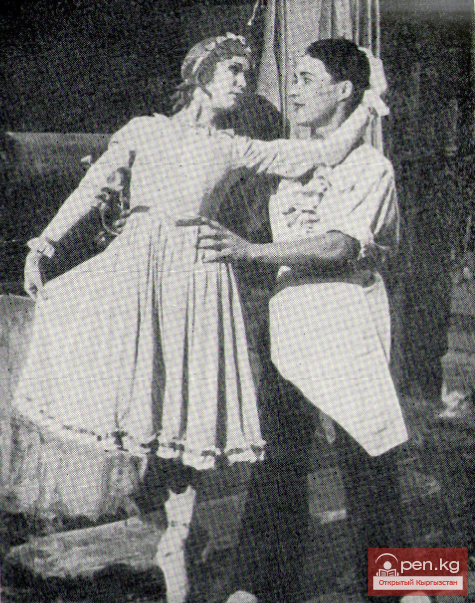
Release of the film 'Cholpon'
The success of the ballet performance 'Cholpon' during the decade of Kyrgyz art in Moscow (1958) was so great that the idea of its screen adaptation arose. Prominent artists of Soviet cinema took on the task. The director was the honored artist of the RSFSR and the Kyrgyz SSR Roman Tikhomirov (known to audiences for the film 'Eugene Onegin'), and the chief cameraman was Apollinary Dudko. "Using the experience gained from working on the film 'Eugene Onegin' — noted R. Tikhomirov — we strive not just to mechanically transfer the theater performance to the screen, but to create an original cinematic work, preserving all the best that exists in the performance."
Although it is difficult to compare such fundamentally different works as 'Eugene Onegin' and 'Cholpon', it should be emphasized that the experience of work that R. Tikhomirov speaks of lies primarily in the method of approaching the material. Despite the fairy-tale nature of the ballet, no sophistication or abstraction was allowed. Everything stemmed from the truth of life, the environment, and the characters.
Before starting work, the film crew familiarized themselves with Kyrgyzstan — its nature, people, history, and folklore.
This helped to create not an abstract exotic film, but a poetic narrative, truthful in its foundation.
The plot twists and ideological direction of the film correspond to the entire spirit of the ballet performance. However, the possibilities of cinema are immeasurably broader than those of a performance limited by the stage. The frames of the fantastic underground gained immense impressive power. It seemed that the power of the sorceress, who commands both the wind and the boiling craters, was great and boundless. But the mistress of dark forces is ultimately defeated by the might of love and loyalty.
The camera lens clearly conveys the nuances of the actors' performances to the audience. Gesture, movement, and gaze became more visible and effective. The refined mastery of choreography was more vividly manifested in the performances of B. Beishenaliev as Aydai, R. Chokoeva as Cholpon, U. Sarbagishev as Nurdin, S. Abdujalilov as the genie, and the entire corps de ballet led by Nurdin Tugelov.
Composer M. Raukhverger had to work thoroughly on the ballet's score. The artist Alexander Black also worked hard on the decorations. At the 'Lenfilm' studio, under the guidance of the head of decorative-mechanical structures A. Lapshin, complex fairy-tale decorations depicting a fantastic underground, the splendor of Aydai's palace, mountain plateaus, and gorges were created, although many location shoots were conducted in the foothills of the Tien Shan and on the shores of Issyk-Kul.
In the autumn of 1959, the film 'Cholpon' was completed. Since then, it has traveled across the screens of many countries around the world. It was shown in Bulgaria, Romania, the GDR, DRV, China, Mongolia, Poland, Cuba, the USA, Australia, New Zealand, Canada, Colombia, Uruguay, West Germany, Austria, the Netherlands, Singapore, Ceylon, Iraq, Iran, Syria, Afghanistan, Libya, Tunisia, Israel, Togo, Guinea, Mali, the Republic of South Africa, Kenya, Uganda, Tanganyika, Mozambique, South Africa, the Federation of Rhodesia and Nyasaland, South West Africa, and Central American countries.
Reviews from foreign press unanimously emphasize the interest of the Western audience in Kyrgyz ballet and the high level of artistry of the performers. Reviews from various newspapers are unanimous in their assessments of Kyrgyz ballet. For example, the Danish conservative newspaper 'Berlingske Tidende' wrote in its issue of March 27, 1961, in a review titled 'Fairy-Tale Ballet': "The dancers possess a quality that cannot fail to impress and completely enchant the audience... This performance was executed with great enthusiasm and an outstanding ballet cast, with such brilliant soloists that one always watches with pleasure."
The production of the film 'Cholpon' had immense political and aesthetic significance, showcasing to the world the real fruits of the cultural revolution in our country. The former tsarist colony that Kyrgyzstan was before the revolution has reached the heights of true professional art. It captivates people's hearts with talent, skill, national originality, realism, and high idealism.
Significant role in the artistic design of the ballet 'Cholpon' by A. V. Arefyev









































